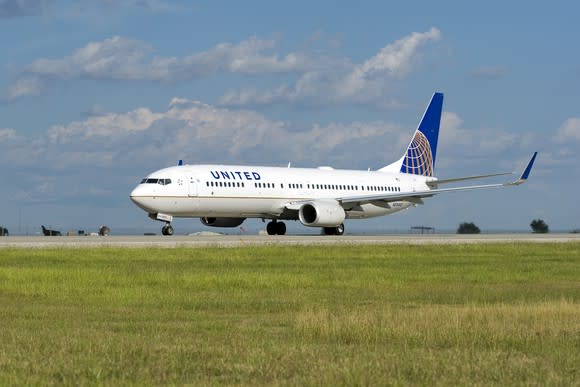United Continental: On Course to Lose Money Next Quarter?
Entering 2017, investors were hopeful that the new management team at United Continental (NYSE: UAL) would drive a turnaround at the long-struggling airline. Instead, the company is on pace to turn in yet another disappointing performance this year.
To make matters worse, United's management hasn't made a convincing argument that results will improve meaningfully in the near future. In fact, there appears to be a significant chance that United Continental will lose money in the first quarter of 2018.
Profitability is eroding rapidly
During 2017, companies across the U.S. airline industry have been hit by unit cost increases. Wage inflation is putting pressure on non-fuel unit costs, while jet fuel prices have spiked. Many airlines have been able to offset some of this cost creep through higher unit revenue, but not United Continental.
United's revenue per available seat mile (RASM) is down 0.3% year to date, with a big third-quarter decline more than offsetting an increase in the first half of the year. RASM is expected to sink once again in the fourth quarter.

United's unit revenue has started to decline again. Image source: United Airlines.
The result has been rapid margin deterioration. In Q1, United's adjusted pre-tax margin plunged to 2.3% from 8.4% a year earlier. Its adjusted pre-tax margin fell by just 1.3 percentage points in Q2 (from 14.5% to 13.2%). However, margin erosion accelerated again in Q3, as United's pre-tax margin fell to 10.4% from 15.7% a year earlier.
Looking at the first three quarters together, United's adjusted pre-tax margin has fallen by more than 4 percentage points, reaching 9%. The company's Q4 guidance implies that it will suffer an even bigger margin decline this quarter.
The Q1 outlook isn't good
United's management blamed the weak Q3 performance on rising fuel prices, the impact of Hurricane Harvey, and some strategy missteps. It attributed the weak fourth-quarter margin outlook to higher fuel prices (again) and the timing of school vacations in December.
However, while United Continental wants to attribute its problems to short-term issues, it will still encounter plenty of headwinds in 2018. On the cost side, oil prices continue to rise. Based on the recent price of jet fuel, United could end up paying close to $2.00/gallon next quarter, up from $1.71/gallon in Q1 2017. That would be a 2- to 3-percentage-point year-over-year headwind to its pre-tax margin.
On the revenue front, United Continental will face tougher year-over-year comparisons in the first half of 2018. RASM fell by 1.8% in Q4 2016, whereas United posted a 0.1% RASM increase in Q1 2017. Meanwhile, competition won't become any easier, as low-fare carriers are set to continue growing in United's markets.
United will probably need RASM growth of at least 1% next quarter to break even. (Recall that United's adjusted pre-tax margin was just 2.3% in Q1 2017 and rising fuel prices will drive a significant increase in unit costs.) That may be hard to achieve, as discounting pressure could become even worse during the lean off-peak months.
Investors should be worried
Even if United Continental does lose money in the first quarter of 2018, it won't have any trouble earning a profit for the full year. The first quarter is seasonally the weakest period for airlines -- particularly for United, which doesn't benefit as much as its rivals from winter-season travel to Florida.
That said, it is never good to be starting the year "in the hole" with a first-quarter loss. This was a big problem for U.S. airlines up until a few years ago. Given the airline industry's poor long-term track record, it isn't comforting to see a return to this historical pattern.
Most worrisome of all, United Continental is still pursuing a dangerous -- and possibly irrational -- strategy of increasing its capacity faster than the rate of GDP growth and slashing economy fares to compete with ultra-low-cost carriers. This will keep its RASM under pressure for the foreseeable future. Investors should probably stay away until United is able to demonstrate more tangible progress in its turnaround effort.
More From The Motley Fool
6 Years Later, 6 Charts That Show How Far Apple, Inc. Has Come Since Steve Jobs' Passing
Why You're Smart to Buy Shopify Inc. (US) -- Despite Citron's Report
Adam Levine-Weinberg has no position in any of the stocks mentioned. The Motley Fool has no position in any of the stocks mentioned. The Motley Fool has a disclosure policy.

